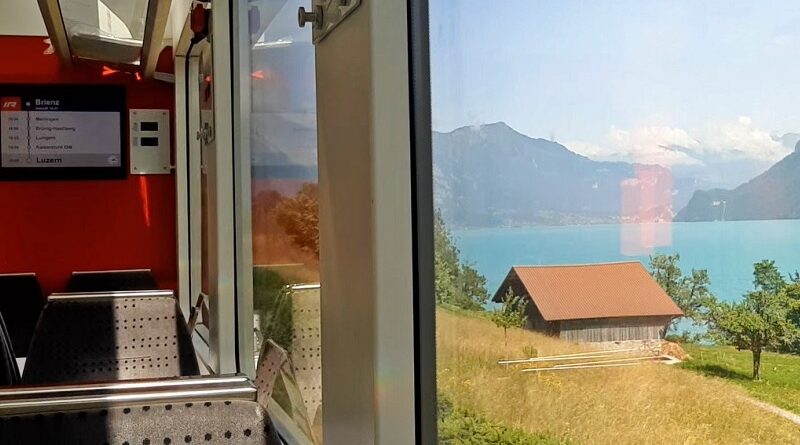Golden Pass: Guide to a Scenic Railway Route Across Switzerland
This guide shows you all you need to know about the trains on the scenic Golden Pass railway route between Montreux and Lucerne.
What is the Golden Pass?
Let’s get one important thing straight first.
Although many people assume the Golden Pass refers to a particular train or railway line, this technically isn’t the case.
The Golden Pass is just a marketing name made up by Swiss railway companies for the scenic rail route between Montreux, Interlaken, and Lucerne.
If you wish to travel the entire Golden Pass rail route between Montreux and Lucerne, or vice versa, you will actually take multiple trains run by different companies, and traverse distinct railway lines.
These trains are used as much by local commuters as they are by foreign tourists, and are an integral part of the Swiss public transport network.
The trains on the Golden Pass railway route are all connected to make for a seamless journey, and riding the entire length of this rail route in one day is perfectly feasible.
However, you might consider making a couple of stopovers en route and taking several days to travel the entire stretch, as you’ll come across some lovely destinations that are well worth a visit.

Different railway lines
When travelling the entire length of the Golden Pass rail route between Montreux and Lucerne (which is called Luzern in the local German language), you traverse the following four railway lines:
– Montreux to Zweisimmen Railway Line
– Zweisimmen to Spiez Railway Line
– Spiez to Interlaken Railway Line (Lake Thun Railway Line)
– Interlaken to Lucerne Railway Line (Brünig Railway Line)
The Montreux to Zweisimmen Line, as well as the Brünig Line, are narrow-gauge (metre-gauge, to be precise) railway lines, while the Zweisimmen to Spiez and Spiez to Interlaken railway lines are standard-gauge.
If you start your journey in Montreux, you will first ride on the narrow-gauge Montreux to Zweisimmen Railway Line, which actually extends beyond Zweisimmen to Lenk im Simmental.
At the station of Zweisimmen, you disembark and change onto a standard-gauge train to Spiez.
Once you reach the town of Spiez, you again change trains, this time taking a train on the standard-gauge railway line along Lake Thun towards Interlaken Ost.
At Interlaken Ost, you make your final transfer, this time boarding a train along the narrow-gauge Brünig Railway Line to Lucerne.
The total distance of the Golden Pass rail route between Montreux and Lucerne is 188 kilometres (117 miles).

Different trains
Travelling the entire length of the Golden Pass route between Montreux and Lucerne normally requires taking four trains operated by different rail companies due to the break of gauge on the distinct railway lines.
However, since December 2022 you can also travel the entire length of the Golden Pass route by only taking two trains, as the state-of-the-art GoldenPass Express started direct services between Montreux and Interlaken Ost in that month.
The GoldenPass Express uses automated gauge conversion, enabling it to traverse both the narrow-gauge railway line between Montreux and Zweisimmen, as well as the standard gauge railway lines between Zweisimmen, Spiez, and Interlaken.
If you take the GoldenPass Express, you therefore only have to change trains once at Interlaken, where you connect with a train along the metre-gauge Brünig Railway Line to Lucerne.
Of course, taking this train service comes with a premium if you want a seat in one of the more luxurious travel classes.
Do note that there is certainly no need to opt for the GoldenPass Express, as you will experience the exact same scenery by taking the regular trains that operate along the Golden Pass route, some of which are quite delightful as well!
Before I show what travelling on the Golden Pass rail route is like in terms of scenic views and sights, let’s first take a look at the different trains you can take, as well as to where and how you can book your ticket.
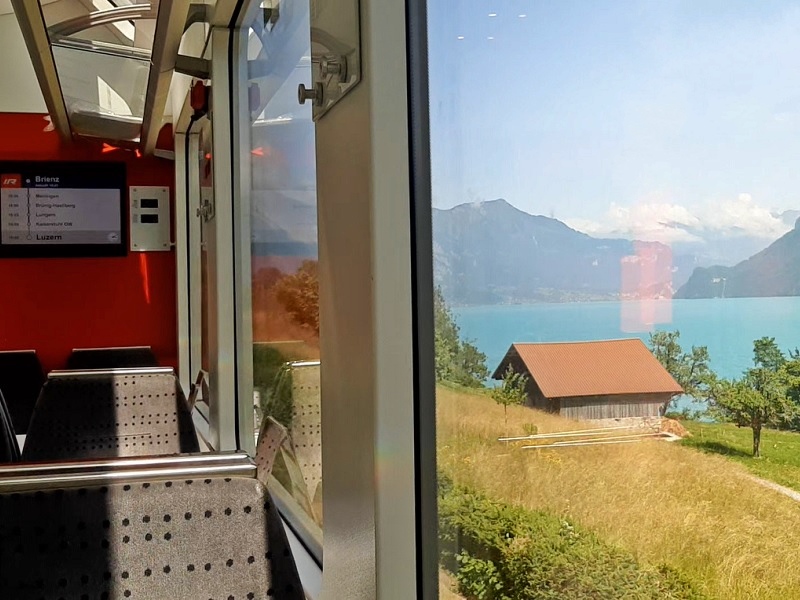

GoldenPass Express
The GoldenPass Express is the most premium train that plies (part of) the Golden Pass rail route.
This train is jointly operated by Swiss transport companies Montreux Oberland Bernois Railway (MOB) and Bern Lötschberg Simplon Railway (BLS) and is primarily tailored towards foreign tourists.
The GoldenPass Express has three classes: Second class, first class, and prestige class, which is the most luxurious.
Seats in second class are arranged two abreast on either side of the aisle, while in first class the seats are a bit more plush and larger, being configured in a 1-2 lay-out and therefore providing you with more comfort and space.
Prestige class, which has seats in a 1-2 configuration as well, is the most luxurious travel class on the GoldenPass Express.
What sets the seats in prestige class apart from seats in first class is that like business class seats on planes, they are fully customisable, allowing them to be reclined and turned around for a forward-facing ride.
The GoldenPass Express has on-board catering for an extra fee in all three travel classes, and you can even elevate your experience by pre-ordering luxurious packages like a champagne and caviar meal at least a day in advance.
There are four daily GoldenPass Express departures in each direction between Montreux and Interlaken Ost – check the MOB website for the current departure times.
Note that the GoldenPass Express only runs between Montreux and Interlaken Ost, so if you want to travel the entire length of the Golden Pass railway route from Montreux to Lucerne or vice versa, you still need to take one of the frequent normal trains between Interlaken and Lucerne.


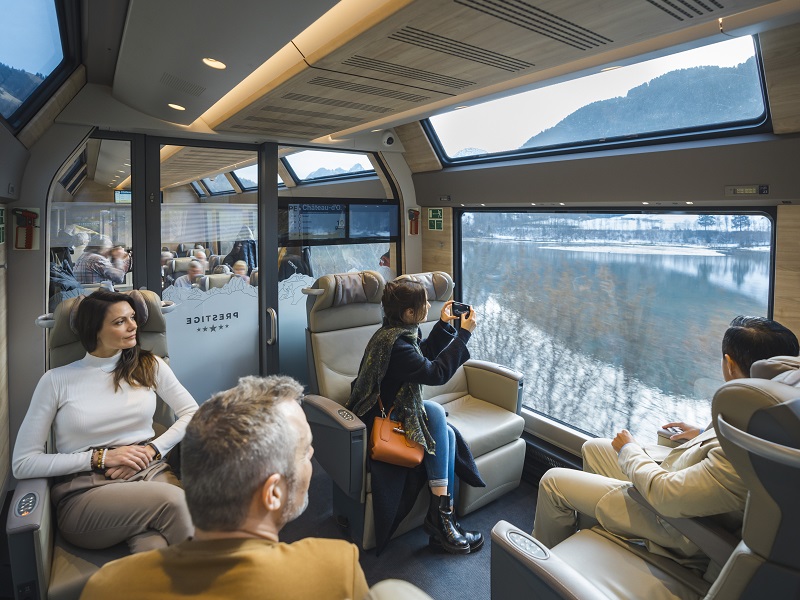
GoldenPass Panoramic
The GoldenPass Panoramic – or Panorama Express – is a train run by Montreux Oberland Bernois Railway (MOB) between Montreux and Zweisimmen.
This modern train has large panorama windows that allow you to completely immerse yourself in the natural beauty of the Swiss scenery around you.
Seats in second class are arranged two abreast on either side of the aisle, while in first class the seats are configured in a 1-2 lay-out, giving you a bit more space and shoulder room.
On each GoldenPass Panoramic train, there are also 8 VIP seats at either the front or back of the train, providing gorgeous views over the railway line.
There is no on-board catering on the GoldenPass Panoramic train.
Currently, there at least 8 daily departures of the GoldenPass Panoramic train in each direction between Montreux and Zweisimmen – check the MOB website which train services these are.


Belle Époque train
When travelling between Montreux and Zweisimmen, you can also opt for the MOB GoldenPass Belle Époque.
The GoldenPass Belle Époque isn’t a train as such, but rather refers to some historic Belle Époque carriages that are attached to some normal MOB train departures on the railway line between Montreux and Zweisimmen.
The first class carriages of the GoldenPass Belle Époque ooze Orient Express-style grandeur and have plush seats in a 1-2 configuration.
This was the way how I travelled on the Golden Pass route between Montreux and Zweisimmen – and I did love every minute of it.
However, the second class carriages of the GoldenPass Belle Époque are a bit more modest and look decidedly less impressive.
There is no on-board catering on the GoldenPass Belle Époque train.
Currently, two train departures in each direction between Montreux and Zweisimmen feature Belle Époque carriages – check the MOB website which train services these are.
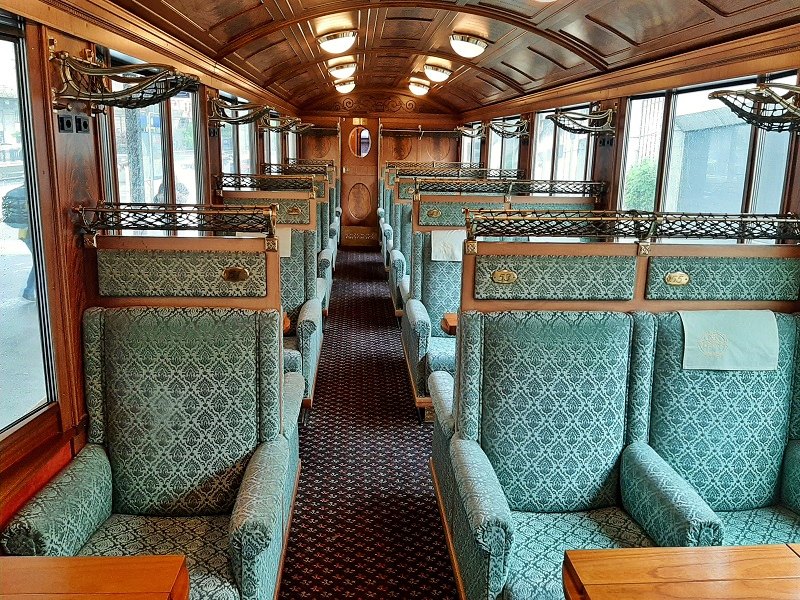
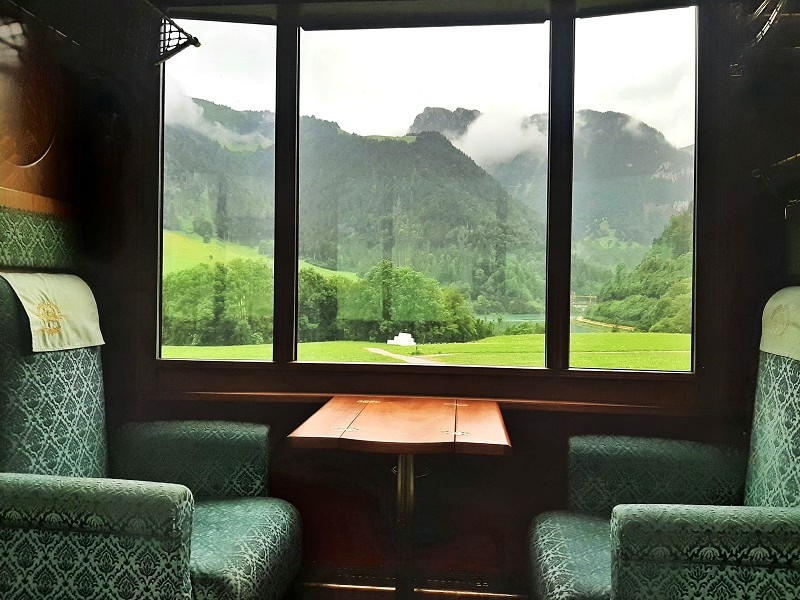
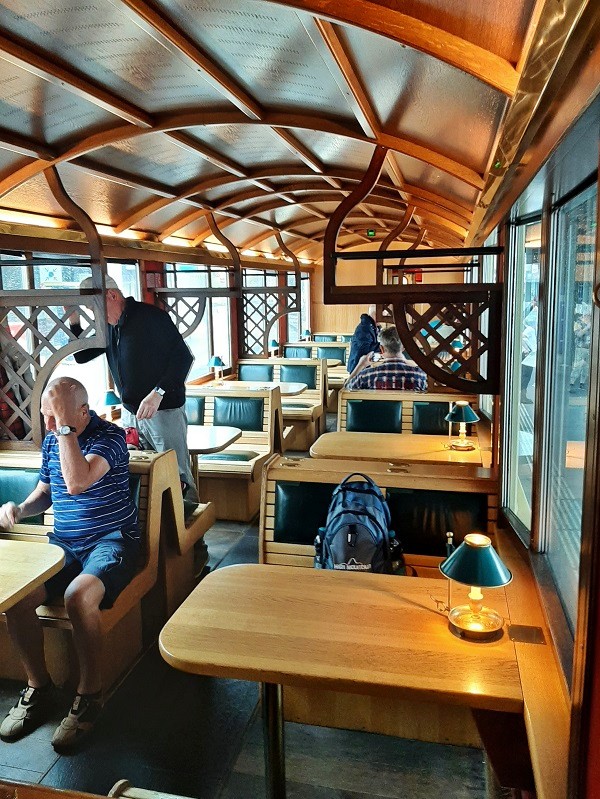
Ordinary trains between Montreux and Zweisimmen
MOB also operates ordinary passenger trains on the railway line between Montreux and Zweisimmen.
These modern trains are primarily used by local commuters, although as a tourist you can of course also make use of them.
While these regular MOB passenger trains may not sound as enticing as some of the other options available between Montreux and Zweisimmen, they are the most frequent ones, and you’ll still enjoy the exact same scenery.
Especially if you plan to make some stopovers en route or aren’t yet sure which train departure you will take, these regular MOB trains might be your best option.
Both first and second class are available on these trains, but there is no catering.


Special excursion trains
The Montreux Oberland Bernois Railway (MOB) also has some special excursion trains between Montreux and Zweisimmen.
The most famous of these excursion trains are the Chocolate Train and the Cheese Train.
If you travel on the Chocolate train, your trip will also include bus transportation and visits to the Cailler chocolate factory in Broc, as well as to the famous cheese-making town of Gruyères.
The Cheese Train on the other hand also includes a visit to a cheese farm in Château-d’Oex, where you get a cheesemaking demonstration and indulge in some Swiss fondue.

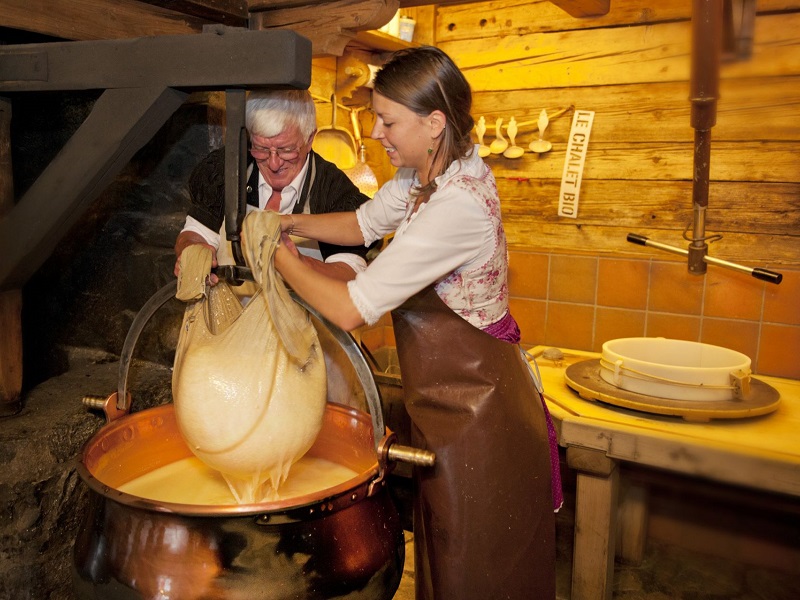
Trains between Zweisimmen and Spiez
If you are not traveling on the luxury GoldenPass Express (which stops at both Zweisimmen and Spiez on its way from Montreux to Interlaken), you need to take one of the regular trains that operate along this railway line.
Trains on the standard-gauge railway line between Zweisimmen and Spiez are operated by the Bern Lötschberg Simplon Railway (BLS), and you’ll typically find a train departing every half hour in each direction.
BLS uses modern passenger trains on this line, with first class seating in a highly spacious and comfortable 1-2 seat configuration, while in second class the seats are arranged two abreast.
On these BLS trains from Zweisimmen to Spiez, you can find a small buffet corner with a vending machine, coffee machine, and four dining tables.
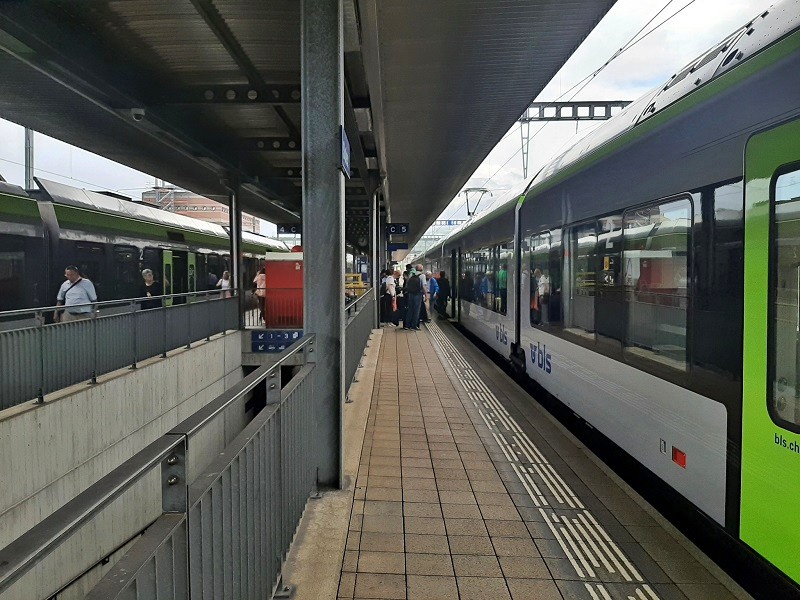
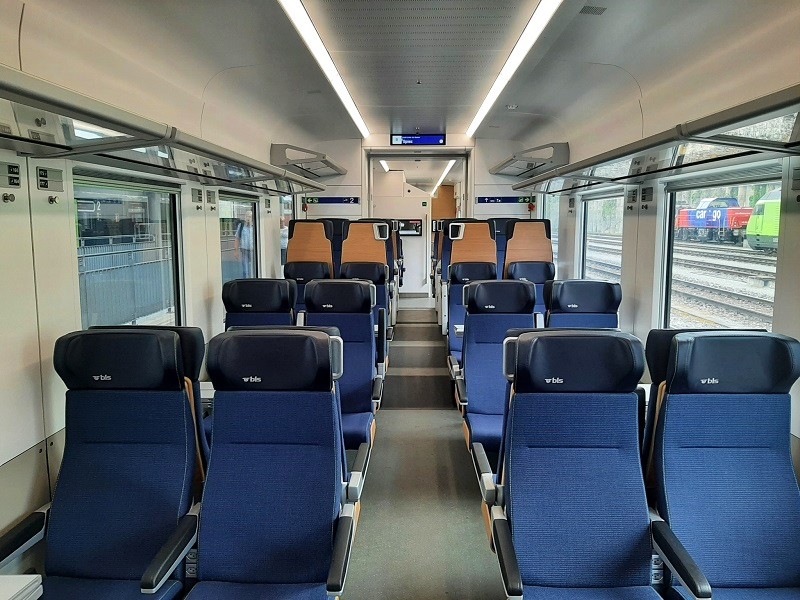
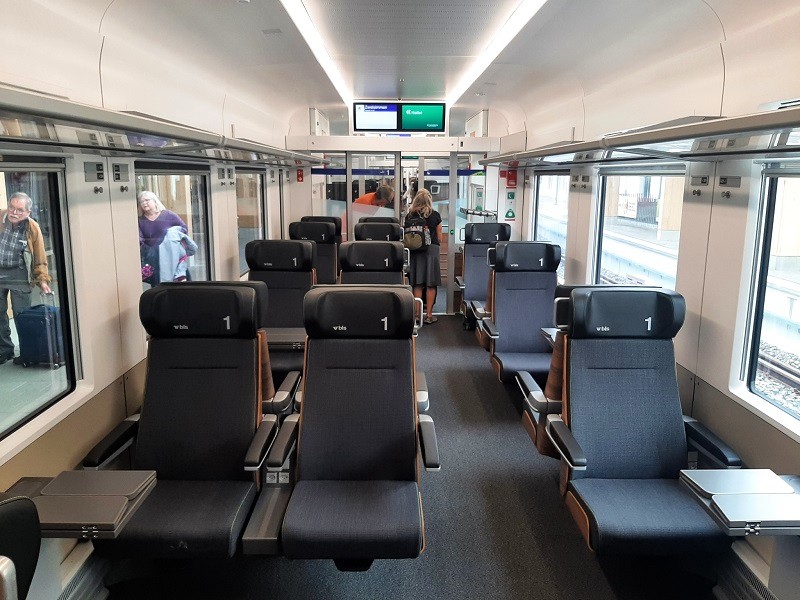
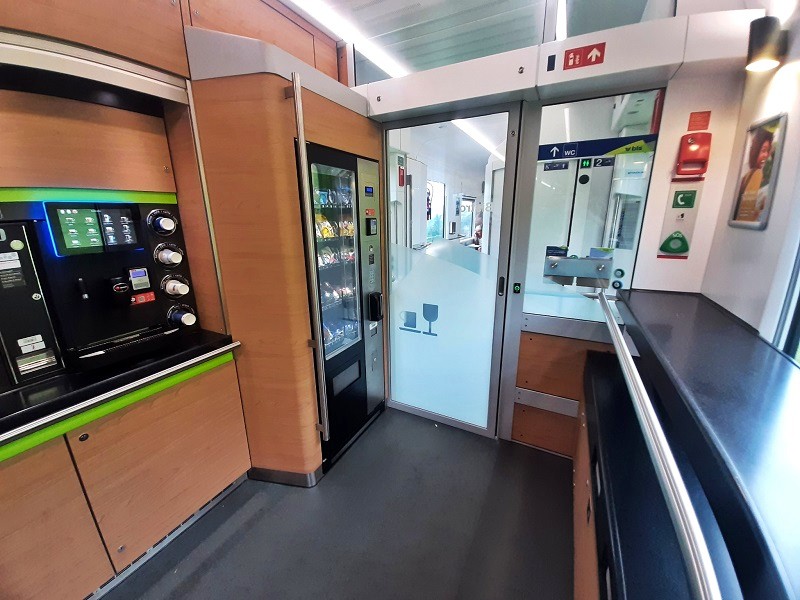
Trains between Spiez and Interlaken Ost
On the standard-gauge Lake Thun Railway Line between Spiez and Interlaken Ost, there is once again quite a variety of trains you can potentially take.
There are Regio Express trains (RE) operated by BLS between Spiez and Interlaken, as well as frequent InterCity (IC) or EuroCity (EC) trains operated by the Swiss Federal Railways (SBB).
Even infrequent InterCity Express (ICE) trains of the German Railways (Deutsche Bahn) ply this route!
If you are flexible about which train to take, you’ll find a departure at least every half hour.
Swiss InterCity and EuroCity trains, as well as the German ICE trains, all have proper dining cars, although given the short duration of the journey between Spiez and Interlaken (it’s just 20 minutes travel time) you would only have time for a quick drink or snack.
While the choice of train between Spiez and Interlaken isn’t that important given it’s just a short trip only, and I would advise first and foremost to select a departure that best fits your schedule, it’s worth noting that IC, EC, and ICE trains are generally more comfortable than RE trains, especially in first class.




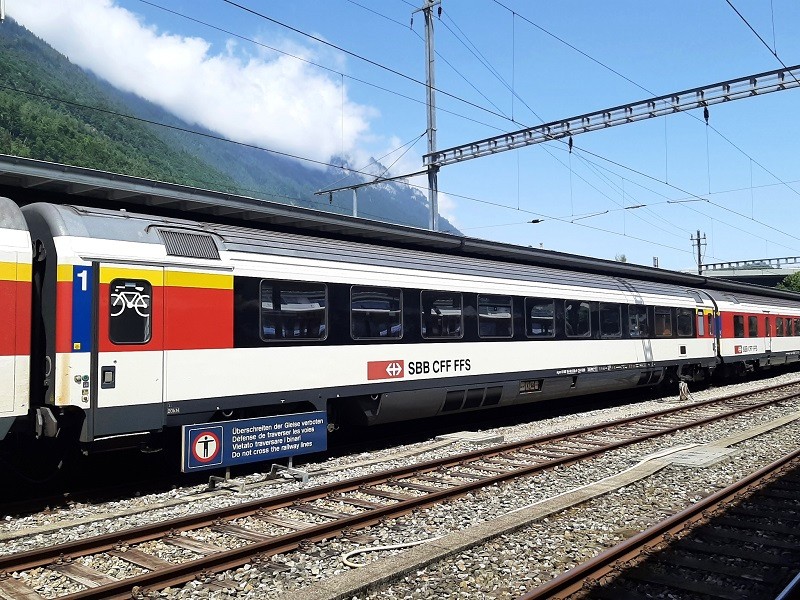

Trains between Interlaken Ost and Lucerne
The trains on the narrow-gauge Brünig Railway Line between Interlaken Ost and Lucerne (Luzern) are operated by Zentralbahn.
Zentralbahn trains between Interlaken Ost and Lucerne depart once an hour in each direction.
Both first and second class coaches have large panoramic windows, with seats in 2nd class being two abreast, while seats in 1st class being more plush and coming in a 1-2 configuration.
On daytime departures, these Zentralbahn trains between Interlaken and Lucerne have a fully functioning dining car serving snacks, drinks and hot meals – a real treat!
I certainly enjoyed visiting the dining car for a delicious green curry and a Swiss beer while watching the wonderful scenery go by.


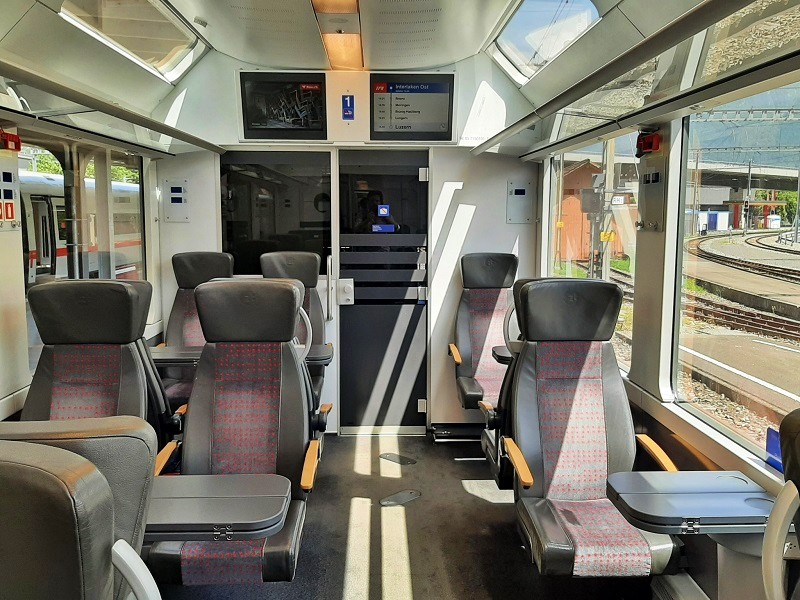

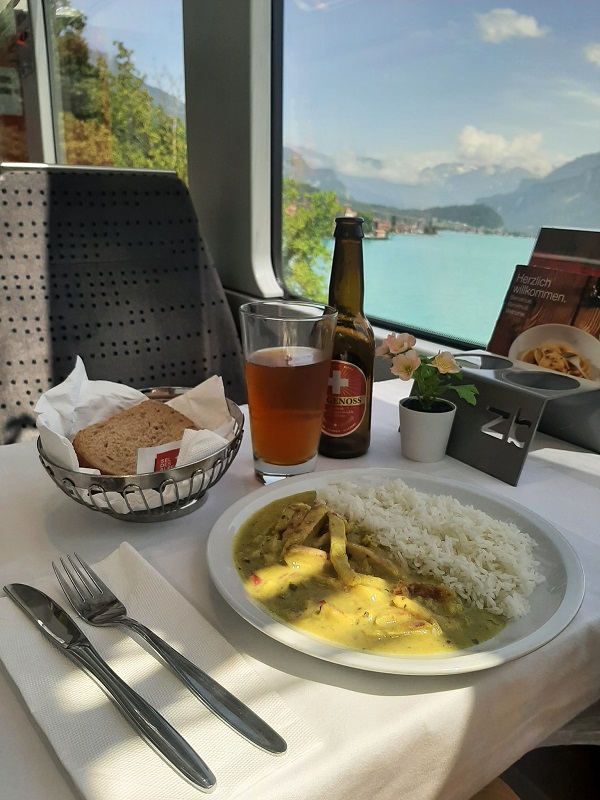
Golden Pass train tickets
To travel along the Golden Pass rail route, you need a train ticket that covers the distance of your journey, such as a train ticket between Montreux and Lucerne if you want to travel the full length, or a train ticket from Lucerne to Spiez if you only wish to travel this part of the route.
With a valid ticket in hand you can technically take any train you want on the Golden Pass route – which also includes such trains as the GoldenPass Express, GoldenPass Panoramic, and GoldenPass Belle Époque.
The exception to the rule is prestige class on the GoldenPass Express, as this requires an extra supplement.
In some cases, it’s also advisable to spend some extra money for a seat reservation on a certain train, although this is always optional and never compulsory.
Before we delve into the world of supplements and seat reservations, let’s first take a look at how Swiss train tickets actually work.
While full-price train tickets in Switzerland are some of the most expensive in all of Europe, you can fortunately find cheaper deals if you book in advance or make use of a train pass.
These are the three most common ticket options in Switzerland:
– Supersaver ticket (valid on the selected connection only – you can’t take any earlier or later train than the departure mentioned on your ticket)
– Saver day pass or day pass (valid for almost all public transport in Switzerland on the day, including on all the trains that ply the Golden Pass rail route)
– Point-to-point ticket (valid on any train on your chosen route on the day)
All the tickets mentioned above can be purchased for either 2nd class or 1st class travel.

Exploring the different ticket options
Supersaver tickets are generally the cheapest, but they are also the least flexible as you are bound to the connection you booked.
These are basically heavily discounted tickets made available in advance with limited availability.
Fully flexible point-to-point tickets, more expensive but always available as they never sell out, provide the flexibility to board any train along the Golden Pass route on the day for which you buy the ticket.
Opting for a Swiss day pass can serve as an excellent compromise, particularly if you intend to cover the entire length of the Golden Pass rail route in a single day.
With a day pass, you can make unlimited use of almost all public transport in Switzerland for a full day, which includes all the trains on the Golden Pass route.
A limited number of discounted Saver day passes are available for any given day in the year – once these are sold out, only the full-fare day pass remains.
If you plan to purchase a day pass, it is advisable to do so as soon as you determine the day you want to travel along the Golden Pass route.
Those who are planning to travel a prolonged time in Switzerland might want to invest in a half-fare travel card (“halbtax”), which gives you a 50% discount on all train tickets, including day passes.

How to book your Golden Pass ticket
You can book your Golden Pass train tickets online on the website of Swiss national railway company SBB, or use third-party booking website Omio.
Alternatively, you can also book your ticket on the website of the MOB, the Montreux Oberland Bernois Railway.
Of course, you can also buy your train ticket at the station in Switzerland, although this way you are unlikely to be able to secure the advance saver tickets.
Note that the prices initially displayed when searching for tickets on the SBB website include a 50% discount, as the Swiss national railway website automatically assumes you possess a half-fare travel card (‘halbtax’), as the majority of people in Switzerland do.
If you do not possess a 50% discount card, you must manually disable this option and set your ticket to “full price” during the booking process on the SBB website, so the cheap tickets initially shown by SBB are unlikely to be valid for you.
Omio‘s search engine is generally more user-friendly for foreign tourists, and they offer train tickets at the same price, accepting all foreign debit and credit cards.
Since Omio has access to the internal booking systems of almost every national railway company in Europe, you can use this highly rated website (4.3 out of 5 rating on Trustpilot) to book all your bus and train tickets for your European trip in one go!
Booking tip
If you intend to travel the full length of the Golden Pass between Montreux and Lucerne in a single day, make sure your ticket reflects the correct route.
The Golden Pass rail route is by far the most scenic way to travel between Montreux and Lucerne – but it isn’t the fastest!
If you search for a ticket between Montreux and Lucerne, the system might put you on the fastest train connection via Lausanne and Olten, bypassing all the scenic mountain scenery of the Golden Pass route.
It’s therefore important that you route your journey through the correct intermediate points, which in case of the Golden Pass route are Zweisimmen, Spiez and/or Interlaken Ost.
When booking at SBB, you can do this by clicking on ‘settings’ and then activating the ‘show via field’ option, which creates an additional input field where you can enter the name of one or multiple intermediate stations.
Of course, you only need to check this if you buy a point-to-point ticket – as there is no need doing so when buying a day pass, given that you have the flexibility to take any train you want.

Golden Pass seat reservations and supplements
Trains on the Golden Pass rail route either offer optional seat reservations, or they don’t have the option to reserve seats at all, in which case it’s free-for-all seating.
It’s your choice whether you want to pay an additional fee to reserve a seat in advance or take your chances and try to secure the best available seats on the train upon boarding.
Below, I’ll outline how you can reserve a seat for each individual train and whether or not it’s worth the effort.
Keep in mind that a seat reservation alone is not a valid ticket – you must also present an actual train ticket to the conductor.
How to reserve your seat
For the GoldenPass Express, seat reservations are optional but highly recommended given its popularity.
A seat reservation for the GoldenPass Express costs 20 CHF (€21.40) in both 2nd and 1st class.
If you want to travel in prestige class on the GoldenPass Express, you need a valid first class ticket and pay a supplement of 49 CHF (€52.40) in order to reserve a seat in this premium class.
If you haven’t bought your ticket yet, you can buy your ticket and seat reservation and/or supplement in one transaction by booking your train at the GoldenPass Express website.
In case you already have a valid train ticket, you can also use this website to make a seat reservation only, or to pay the supplement for prestige class, which you can do by selecting the option “reservation only” during the booking process.
On the GoldenPass Panoramic, as well as on the GoldenPass Belle Époque, seat reservations are optional and cost 10 CHF (€10.70) in both 2nd and 1st class.
You can make a seat reservation for these trains at the MOB website – and when travelling in the high tourist season it is something I would suggest you to do.
Seat reservations aren’t possible on the trains linking Zweisimmen and Spiez – just take any available seat you want!
Between Spiez and Interlaken Ost you can’t make reservations on RE trains, although it is technically possible on IC and EC trains (for 5 CHF, or €5.20) – check the SBB website for details.
Given it’s such a short journey and these trains are never full I really wouldn’t bother with seat reservations here.
On Zentralbahn trains between Interlaken Ost and Lucerne (Luzern), seat reservations are optional and cost between 12 CHF (€12.80) and 16 CHF (€17.10).
You can make seat reservations for Zentralbahn trains through the website of the Luzern tourism board, although personally I wouldn’t bother with this either given that these trains have plenty of capacity and are rarely completely full.

Golden Pass with Interrail or Eurail
With an Interrail or Eurail pass, you are free to take any train along the Golden Pass rail route you want, free of charge.
Unless you want to travel in prestige class on the GoldenPass Express, no supplement is required on any of the trains that ply the Golden Pass railway line.
Seat reservations are optional on some trains, but never mandatory – see the chapter above about ‘Golden Pass seat reservations and supplements’ for more details.
Which side of the train is best to sit on when travelling the Golden Pass?
It varies per individual stretch of railway line which side of the train offers the best views when travelling the length of the Golden Pass rail route.
When travelling by train from Montreux to Zweisimmen, I would say that the right-hand side in the direction of travel is slightly preferable when it comes to scenic views.
You’ll enjoy the best views over Montreux and Lake Geneva, as well as over the mountains of the Gruyère Pays-d’Enhaut Natural Park from the right-hand side of the train when travelling in the direction of Zweisimmen.
However, even the left-hand side has some decent views.
As the railway line zigzags its way up the mountain from Montreux in horseshoe curves, you will also have the opportunity to enjoy scenic views over Lake Geneva from this side of the train.
Moreover, once the train descends down the mountains from Gstaad to Zweisimmen, the best views will be mostly on the left-hand side.
The relatively short stretch between Zweisimmen and Spiez is somewhat of an interlude and it doesn’t really matter which side you are on, as this simply isn’t the most spectacular part of the route.
When travelling from Spiez to Interlaken Ost, you really want to sit on the left-hand side of the train in the direction of travel for some wonderful views over Lake Thun (thus the right-hand side when going from Interlaken to Spiez).
On the Brünig Railway Line from Interlaken to Lucerne (Luzern), the best views by far are on the right-hand side of the train in the direction of travel.
Do note that the trains on the railway line between Interlaken and Lucerne reverse direction in Meiringen.
If you are seated on the right-hand side of the train between Interlaken and Meiringen, it will become the left-hand side when the train reverses and continues its journey to Lucerne.
However, on this part of the railway line it’s the left-hand side is where the best views are, so if you were initially seated on the right-hand side upon departure from Interlaken, make sure you remain seated on this side!
When travelling in the other direction from Lucerne to Interlaken, you should therefore also sit on the right-hand side of the train for the best views, which automatically becomes the left-hand side of the train after it has reversed at Meiringen.

Stopovers when travelling on the Golden Pass rail route
Although you can easily complete the entire Golden Pass rail route between Montreux and Lucerne in a single day, there is a lot to see and do along the railway line so you might want to make some stopovers!
Interlaken serves as an excellent base for exploring the Bernese Highlands (Berner Oberland), where you can discover numerous scenic funiculars and hiking trails, such as the one leading to Harder Kulm.
Or go from Interlaken to nearby Lauterbrunnen or Grindelwald and take the Wengernalp rack railway up the mountain pass to Kleine Scheidegg.
With its castle and vineyards overlooking Lake Thun, the town of Spiez is a personal favourite of mine and also well-worth a stopover.
On the stretch of the Golden Pass rail route between Zweisimmen and Montreux, the ski resort of Gstaad is arguably the most popular place for a stopover – although this jet-set destination comes with prices that match its reputation!
Just off the Golden Pass rail route, Gruyères has a fine medieval old town and castle, and is of course well-known for its cheese.
When travelling between Montreux and Zweisimmen on the Golden Pass line, get off at the station of Montbovon and change here for a train to Gruyères.
Make sure that if you plan to make a stopover along the route for a few hours, your train ticket permits this.
I would recommend purchasing a Swiss day pass if you intend to make short stopovers, as it provides the most flexibility, allowing you to decide on the spot how long you want to stay and which train to take next.
Making an overnight stop somewhere along the Golden Pass route effectively means buying two train tickets, one for each day.

How to plan your train journey on the Golden Pass
All this information about the Golden Pass might be a lot to unpack and if you are a first-time train traveller planning your trip might sound daunting!
I would recommend planning the trip in stages, starting with the first segment or train from your point of departure.
Use online train planners, like the route planner on the SBB website, to check train schedules.
For example, decide whether you want to start by taking one of the GoldenPass Express trains directly from Montreux to Interlaken or prefer another train, such as the GoldenPass Panoramic or Belle Époque from Montreux to Zweisimmen.
Once you know your arrival time in Zweisimmen, you can check which train you prefer to take next from Zweisimmen to Spiez.
Swiss trains are scheduled to provide seamless connections, so what might seem like a tight 5-minute connection between trains is in reality easily doable.
Trains in Switzerland generally run perfectly on time, and in the rare event of a minor delay, a connecting train may be held at the station for a few extra minutes to facilitate passengers making their planned connection.
If you happen to miss a train connection, you can simply take the next available train, provided it’s booked on a single ticket or you are traveling with a Swiss day pass, Interrail, or Eurail.
However, in case you miss the train you originally planned to take, you will lose your seat reservation if you had made one.
When planning your journey, it’s never a bad idea to allow for some extra buffer time, especially before a train you really don’t want to miss.
For instance, if you are traveling from Lucerne to Interlaken and plan to take the GoldenPass Express from there to Montreux in expensive prestige class seats that you’ve booked, I wouldn’t feel comfortable with a short 10-minute connection, even though in most cases, you will likely easily make it!
Similarly, check whether you can still reach your intended final destination for the day on later trains if you happen to miss a train somewhere along the route due to a delay.

Food and drinks
Although some of the trains on the Golden Pass rail route have a dining car or on-board catering, you are also free to bring your own food and drinks on board.
This includes alcohol – so feel free to bring a beer or even a bottle of wine, if you want!

Conclusion
The Golden Pass refers to a scenic Swiss rail route between Montreux and Lucerne (Luzern) and not to a specific train or railway line, what a lot of people mistakenly think.
In fact, when traversing the full length of the Golden Pass from Montreux to Lucerne or vice versa, you travel on four distinct railway lines (two narrow-gauge, and two standard-gauge lines) and take multiple trains.
You can choose the state-of-the-art GoldenPass Express, embrace the old-world charm of the Belle Époque train, or opt for one of the numerous local trains that operate along the route.
No matter which train you end up taking, you will enjoy some fabulous views over high Alpine peaks, deep blue lakes, dense forests and picturesque Swiss villages when travelling the length of the Golden Pass.
Whether you are an avid train traveller or just want to absorb Switzerland’s beautiful natural landscapes, the Golden Pass makes for a fabulous trip.
Trip report index
This article is part of the ‘Scenic Trains Around Switzerland and the Italian Lakes‘ trip report, which consists of the following chapters:
1. Bergamo: A Visit to Lombardy’s Beautiful Hilltop Town
2. Travelling From Bergamo to Milan by Train
3. From Milan to Varenna and Tirano By Trenord Regional Train
4. A Varenna Visit: A Day Trip to Lake Como’s Most Beautiful Town
5. Tirano: The Italian Gateway to the Bernina Railway
6. Bernina Express Train: Guide to Switzerland’s Most Scenic Railway
7. Review: Swiss InterCity (IC) Train Chur to Zurich and Basel
8. From Zurich to Geneva on a Swiss ICN Tilting Train
9. Cheap Geneva Hotel: Stay Across the Border in Annemasse!
10. Around Lake Geneva by Train: From Geneva to Montreux
11. A Visit to Montreux and the Freddie Mercury Statue
12. Golden Pass: Guide to a Scenic Railway Route Across Switzerland (current chapter)
13. Swiss Chique: The MOB GoldenPass Belle Époque Train
14. From the Mountains to the Lake: Zweisimmen to Spiez by Train
15. Spectacular Spiez: A Visit to a Scenic Swiss Town
16. Spiez to Interlaken by Train: A Trip on the Lake Thun Railway Line
17. Review: Interlaken to Lucerne by Zentralbahn Train
18. Lucerne: Exploring One of Switzerland’s Most Beautiful Cities
19. From Lucerne to Locarno: By Train Across the Gotthard
20. A Visit to Locarno and the Sanctuary of Madonna del Sasso
21. Centovalli Railway: By Train From Locarno to Domodossola
22. Stresa: Grand Hotels, Lakeside Views, and the Borromean Islands
23. Review: Trenitalia Frecciarossa High-Speed Train Milan to Bologna

